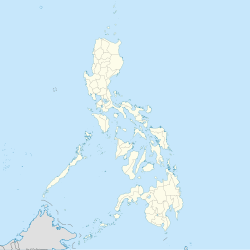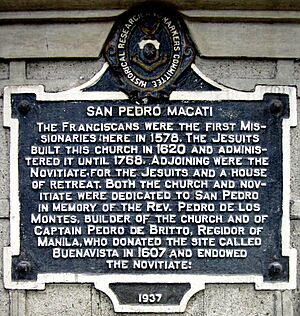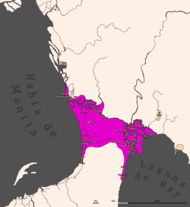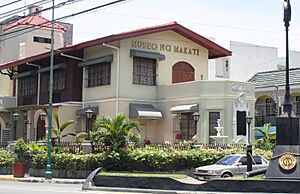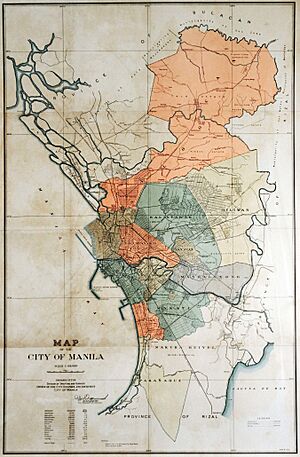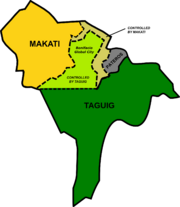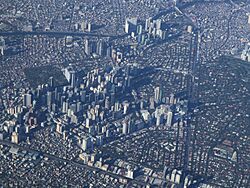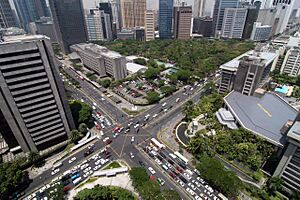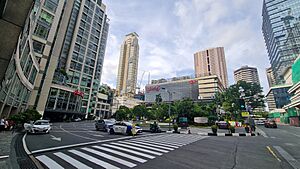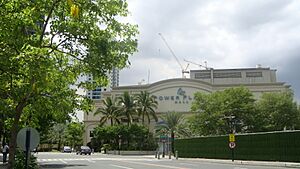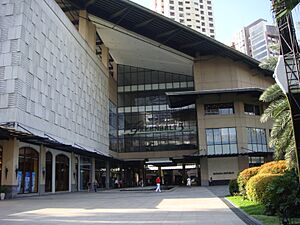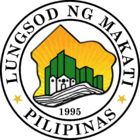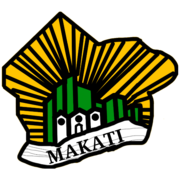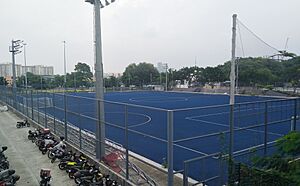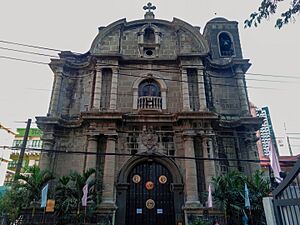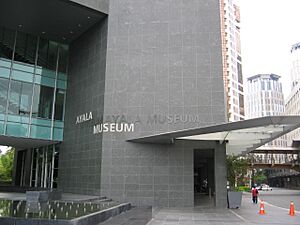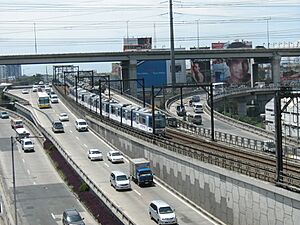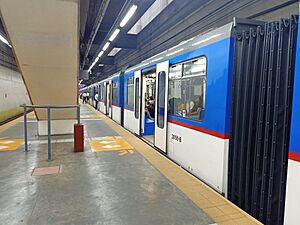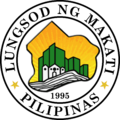Makati facts for kids
Makati (pronounced mah-KAH-tee) is a busy and important city in the Philippines. It's known as one of the country's main financial centers. Many big international and local companies, banks, and even foreign embassies are located here. Makati is also a lively place for culture and entertainment in Metro Manila.
In 2020, Makati had a population of 629,616 people. However, after a land dispute in 2023, its population was adjusted to 292,743. This makes it the 14th most populated city in Metro Manila. Makati is also one of the most densely populated cities in the world. In 2023, Makati had the highest GDP per person in the Philippines, showing how strong its economy is.
Quick facts for kids
Makati
|
|||||
|---|---|---|---|---|---|
|
Highly urbanized city
|
|||||
|
Skyline of Makati City
Ayala Triangle
Circuit Makati
Poblacion
Rockwell Center
Makati City Hall
Nuestra Señora de Gracia Church
|
|||||
|
|||||
| Etymology: San Pedro [de] Macati | |||||
| Nickname(s):
Financial Capital of the Philippines
|
|||||
| Motto(s):
Makati, Mahalin Natin, Atin Ito.
("Makati, let us love it, it is ours.") |
|||||
| Anthem: Himno ng Makati English: Makati Hymn Martsa ng Makati English: Makati March |
|||||
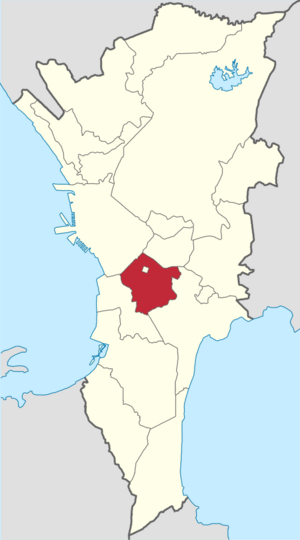
|
|||||
|
OpenStreetMap
|
|||||
| Country | Philippines | ||||
| Region | National Capital Region | ||||
| Province | none | ||||
| District | [[{{#property:P7938}} | — Lua error in Module:Wd at line 1804: attempt to index field 'wikibase' (a nil value).]] | ||||
| Founded | June 1, 1670 (as San Pedro de Macati) |
||||
| Renamed | February 28, 1914 (as Makati) |
||||
| Cityhood | February 4, 1995 | ||||
| Recent territorial change | November 9, 2023 | ||||
| Barangays | 23 | ||||
| Government | |||||
| • Type | Sangguniang Panlungsod | ||||
| Area | |||||
| • Total | 18.17 km2 (7.02 sq mi) | ||||
| Elevation | 32 m (105 ft) | ||||
| Highest elevation | 465 m (1,526 ft) | ||||
| Lowest elevation | 0 m (0 ft) | ||||
| Population
(2024 census)
|
|||||
| • Total | 309,770 | ||||
| • Density | 16,111/km2 (41,730/sq mi) | ||||
| • Households | 89,638 | ||||
| Demonym(s) | Makiteño; Makatizen | ||||
| Economy | |||||
| • Income class | 1st city income class | ||||
| • Poverty incidence |
|
||||
| • HDI | |||||
| • Revenue | ₱ 19,259 million (2022), 21,199 million (2023) | ||||
| • Assets | ₱ 238,262 million (2022), 242,444 million (2023) | ||||
| • Expenditure | ₱ 19,651 million (2022), 20,174 million (2023) | ||||
| • Liabilities | ₱ 15,695 million (2022), 16,401 million (2023) | ||||
| Service provider | |||||
| • Electricity | Manila Electric Company (Meralco) | ||||
| Time zone | UTC+8 (PST) | ||||
| ZIP code |
1200–1213, 1219–1235
|
||||
| PSGC |
[https://psa.gov.ph/classification/psgc/?q=psgc/barangays/{{#pro000®code={{&provcode=
|
||||
| IDD : area code | +63 (0)02 | ||||
| Native languages | Tagalog | ||||
| Major religions | Roman Catholic Church | ||||
| Feast date | December 12 | ||||
| Catholic diocese | Roman Catholic Archdiocese of Manila | ||||
| Patron saint | Saints Peter and Paul, Virgen de la Rosa | ||||
| Website | www |
||||
Contents
- What's in a Name? The Story of Makati
- Makati's Journey Through Time
- Makati's Location and Climate
- People of Makati
- Makati's Economy and Shopping
- How Makati is Governed
- Culture and Fun in Makati
- Getting Around Makati
- Learning in Makati
- Famous People from Makati
- Makati's Global Connections
- Images for kids
- See also
What's in a Name? The Story of Makati
The name Makati comes from the Tagalog word kati. This word means "low tide" or "ebb tide." It refers to how the nearby Pasig River's water level changes.
The story goes that in 1571, a Spanish Governor-General named Miguel López de Legazpi asked locals for the name of the place. They replied, “Makati na! Kumakati na!” which means "It's low tide! The tide is ebbing!" He then wrote down the name as "Macati."
Before 1914, the city was called San Pedro Macati. This name honored Saint Peter, its patron saint. It was also named after Spanish captain Pedro de Brito and a priest, Rev. Fr. Pedro de los Montes.
Makati's Journey Through Time
Early Beginnings
Long ago, parts of Makati were part of an old kingdom called Namayan. Its capital was in what is now the Santa Ana district of Manila.
Spanish Rule and Growth
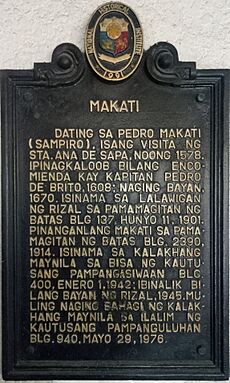
During the Spanish colonial era, Makati became a small settlement of Santa Ana de Sapa in 1578. In 1589, Captain Pedro de Brito bought land here and started "Hacienda Pedro." He and his wife later gave half of the land to the Jesuits to build a church. This church, now known as Saints Peter and Paul Parish Church, was finished in 1620.
Makati officially became a town on June 1, 1670, and was named San Pedro de Macati. In 1851, Don José Bonifacio Roxas bought the land. Since then, the Ayala Corporation, linked to the Roxas family, has played a big part in Makati's growth.
American Era and Name Change

In 1901, San Pedro Macati became part of the new Rizal province. On February 28, 1914, its name was shortened to "Makati."
By 1934, Makati had 14 barangays (small districts). Some areas like Fort McKinley were added from nearby towns.
World War II and Post-War Boom
During World War II, Makati was briefly merged into the "City of Greater Manila." After the war, Makati grew very quickly. New communities and office buildings were built, especially by Ayala y Compañía. By the late 1960s, Makati became the financial and business heart of the Philippines.
In 1975, Makati became a municipality within the National Capital Region (Metro Manila).
Modern Makati and City Status
Makati became a center for protests against the government in the 1980s. These protests, known as the Confetti Revolution, helped lead to the 1986 People Power Revolution. This event changed the country's leadership.
On January 2, 1995, Makati officially became a city. This was approved by a vote one month later.
Recent Changes and Land Disputes
In 2023, after a long legal dispute, the Supreme Court ruled that several barangays (known as the Embo barangays) previously managed by Makati now belong to Taguig City. This decision changed Makati's size and population. Makati lost about 300,000 people and its borders with Pasig and Pateros.
The court also ordered Makati to allow Taguig access to public properties in these areas. Taguig has since reopened these facilities to continue public services for the residents.
Makati's Location and Climate
Where is Makati?
Makati is right in the middle of Metro Manila. The Pasig River borders it to the north, Taguig to the east, Pasay to the southwest, and Manila to the northwest. Several creeks also form parts of its boundaries. Makati covers an area of about 18.17 square kilometers.
Makati's Weather
Makati has a tropical monsoon climate. This means it's always warm, rarely going below 20°C or above 38°C. The humidity is usually high, making it feel even warmer. It has a short dry season from January to May and a longer wet season from June to December.
| Climate data for Makati | |||||||||||||
|---|---|---|---|---|---|---|---|---|---|---|---|---|---|
| Month | Jan | Feb | Mar | Apr | May | Jun | Jul | Aug | Sep | Oct | Nov | Dec | Year |
| Mean daily maximum °C (°F) | 30 (86) |
30 (86) |
31 (88) |
33 (91) |
34 (93) |
34 (93) |
33 (91) |
31 (88) |
31 (88) |
31 (88) |
31 (88) |
31 (88) |
31.7 (89.1) |
| Mean daily minimum °C (°F) | 21 (70) |
21 (70) |
21 (70) |
22 (72) |
23 (73) |
24 (75) |
24 (75) |
24 (75) |
24 (75) |
24 (75) |
23 (73) |
22 (72) |
22.75 (72.95) |
| Average precipitation mm (inches) | 25.4 (1.00) |
25.4 (1.00) |
38.1 (1.50) |
25.4 (1.00) |
38.1 (1.50) |
127 (5.0) |
254 (10.0) |
431.8 (17.00) |
406.4 (16.00) |
355.6 (14.00) |
203.2 (8.00) |
152.4 (6.00) |
2,082.8 (82.00) |
| Source: makaticity.com | |||||||||||||
Dealing with Climate Change
The Philippines is one of the countries most affected by extreme weather. Makati, being a low-lying city, is vulnerable to typhoons, floods, and landslides. The city has seen an increase in rainfall over the years.
In August 2022, Makati declared a "climate emergency." This means the city is taking serious steps to address the effects of climate change. Makati has programs to help its residents prepare for climate change. These include better health services, emergency response, and environmental protection. The city plans to buy more electric vehicles, install solar panels on public buildings, and improve public transport. These actions aim to reduce harmful gases that contribute to climate change.
Makati's Cityscape
People of Makati
As of the 2020 census, Makati's population was 629,616. After the territorial dispute in 2023, the population was adjusted to 292,743. Most people in Makati are Roman Catholic. Other religions also have many followers in the city.
During weekdays, Makati's daytime population is estimated to be 3.7 million. This is because many people come to work, do business, or shop. This large number of people helps Makati's economy. However, it also causes heavy traffic and puts pressure on the city's services.
Makati's Economy and Shopping
A Hub for Business
Makati has the highest GDP per person in the Philippines. Its economy is very strong and diverse. The Ayala Triangle in the Makati Central Business District (CBD) is home to many multinational companies, banks, and large businesses. You can also find fancy shops, restaurants, and a park called Ayala Triangle Gardens there.
The Philippine Stock Exchange, where stocks are traded, used to be in Makati. Makati is a major office market in Metro Manila. The city has not raised its tax rates since 2006 and has been financially stable for about 30 years.
Many of the tallest buildings in Metro Manila are in Makati. These include PBCom Tower and Trump Tower Manila. PBCom Tower was the country's tallest office building for many years.
Shopping Paradise
Makati is famous for its shopping centers. You can find international and local shops, high-end boutiques, restaurants, and entertainment.
The Ayala Center is a huge shopping area in the Makati CBD. It has many malls like Greenbelt, Glorietta, and Ayala Malls One Ayala. These malls offer a wide range of shopping, dining, and entertainment options. You can also find major department stores like SM Makati and Rustan's here.
Other popular shopping centers in Makati include Power Plant Mall, Century City Mall, and Ayala Malls Circuit.
How Makati is Governed
Local Leadership
Makati is a "highly urbanized city." The city government is located at the Makati City Hall. The city is led by a mayor, who is the chief executive. The mayor is helped by a vice mayor and a city council. The council has 18 members who create the city's policies.
The current mayor is Nancy Binay. The vice mayor is Romulo "Kid" Peña Jr. Makati also has representatives in the House of Representatives.
City Seal
Makati's current seal was adopted in 1995. It shows an outline map of Makati with 33 rays, green buildings, a church, and a river.
The golden yellow map represents wealth. The rays stand for the 33 barangays of Makati, moving towards a bright future. The green buildings symbolize new growth. The church represents the Nuestra Señora de Gracia Church, an old church used by Filipino revolutionaries. The waves represent the "ebbing tide" from the phrase "Makati na, Kumakati na."
- Former municipal seals of Makati
Culture and Fun in Makati
Makati has many art museums, old churches, and places for recreation. You can find the Manila Golf Club and the Manila Polo Club in Forbes Park. The Makati Sports Club is another popular place for sports. The Makati Coliseum hosts big sports events.
The Blue Pitch at Circuit Makati is a multi-use stadium for football games. The Ayala Museum is a private museum with exhibitions like "Gold of Ancestors," showing ancient golden artifacts. Other museums include the Yuchengco Museum and the Museo ng Makati.
Makati has several old Spanish churches, such as Saints Peter and Paul Parish and Nuestra Señora de Gracia Church. The Santuario de San Antonio is a popular church for weddings.
Getting Around Makati
Roads and Highways
Major roads like EDSA and the South Luzon Expressway (SLEX) pass through Makati. The Skyway, an elevated expressway, connects Makati to other parts of Luzon. The Magallanes Interchange is a complex system of elevated roads where SLEX and EDSA meet.
Guadalupe and Ayala Center are major transport hubs. Ayala Center has a transport hub called One Ayala. The BGC Bus connects Makati to Bonifacio Global City. Buses and jeepneys travel through Makati's main roads. Tricycles are used for shorter distances.
Makati was one of the first cities to try e-jeepney and hybrid bus services. These buses use both electric and diesel motors to help reduce pollution.
Train Systems
The MRT Line 3 has four stations in Makati: Guadalupe, Buendia, Ayala, and Magallanes. The Philippine National Railways (PNR) used to serve Makati, but its operations stopped. A new train line, the North–South Commuter Railway, will have two stations in Makati: Buendia and EDSA.
There were plans for a monorail and a subway system in Makati. However, the subway project faced delays due to the transfer of the Embo barangays to Taguig.
Water Transport
The Pasig River Ferry Service has one station in Makati, located in Valenzuela.
Learning in Makati
The University of Makati is the city's main public university. Other higher education institutions in Makati include the Asian Institute of Management (AIM) and Don Bosco Technical Institute of Makati.
Many universities from outside Makati also have campuses or programs here. These include Ateneo de Manila University, De La Salle University, and Far Eastern University.
As of 2024, Makati City oversees 23 public schools. However, in 2023, 14 public schools, including Makati Science High School, were transferred to Taguig City due to the territorial dispute.
Famous People from Makati
Makati has been home to many notable individuals:
- Pío del Pilar, a Filipino revolutionary general
- Jejomar Binay, former Vice President of the Philippines
- Nancy Binay, former senator and current mayor
- Abigail Binay, former city mayor
- Michelle Dee, actress
- Vhong Navarro, TV host, actor, and dancer
- Ciara Sotto, actress
- Jhong Hilario, actor, dancer, TV host, and former councilor
- Teodoro Locsin Jr., journalist, lawyer, and diplomat
- Monsour del Rosario, actor, athlete, and former representative
- Joker Arroyo, lawyer and former senator
- Agapito Aquino, former senator
- Rico J. Puno, singer and former councilor
- Chiquito, actor and former vice mayor
- Sandro Reyes, a player for the Philippines national football team
- Rhian Ramos, actress
- Mike Arroyo, former First Gentleman
- Bela Padilla, actress
- Heaven Peralejo, actress
- Albie Casiño, actor
- CJ Tañedo, painter
Makati's Global Connections
Diplomatic Offices
Many foreign countries have their embassies or consulates in Makati. This shows Makati's importance in international relations.
 Angola
Angola Argentina
Argentina Australia
Australia Austria
Austria Bangladesh
Bangladesh Belgium
Belgium Brazil
Brazil Brunei
Brunei Bulgaria (Consulate)
Bulgaria (Consulate) Cambodia
Cambodia Canada
Canada Chile
Chile China
China Czechia
Czechia Egypt
Egypt Finland
Finland France
France Germany
Germany Greece
Greece India
India Indonesia
Indonesia Iran
Iran Iraq
Iraq Ireland
Ireland Italy
Italy Libya
Libya Laos
Laos Malta
Malta Malaysia
Malaysia Mexico
Mexico Morocco
Morocco Myanmar
Myanmar Netherlands
Netherlands New Zealand
New Zealand Nigeria
Nigeria Pakistan
Pakistan Peru
Peru Panama
Panama Papua New Guinea
Papua New Guinea Portugal
Portugal Qatar
Qatar Romania
Romania Russia
Russia Saudi Arabia
Saudi Arabia South Africa
South Africa Spain
Spain Sri Lanka
Sri Lanka Switzerland
Switzerland Taiwan (Taipei Economic and Cultural Office)
Taiwan (Taipei Economic and Cultural Office) Ukraine (Consulate)
Ukraine (Consulate) Thailand
Thailand Turkey
Turkey Venezuela
Venezuela
Sister Cities
Makati has "sister city" relationships with other cities around the world and in the Philippines. This helps promote cultural exchange and cooperation.
| International |
|---|
|
| Domestic |
|---|
|
Images for kids
See also
 In Spanish: Macati para niños
In Spanish: Macati para niños












